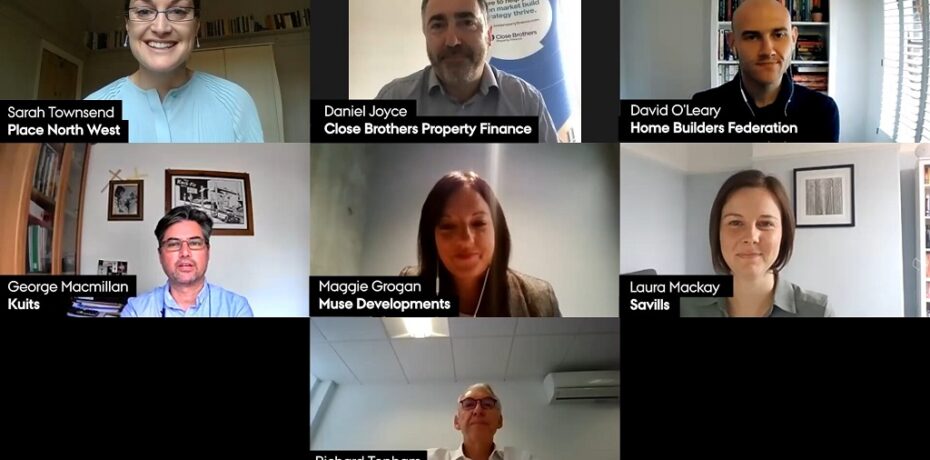Event Summary
Development finance: a mixed landscape | Video + Summary
The Covid-19 pandemic has made lenders more wary, skewing the market in favour of larger developers with proven track records at the expense of SMEs, according to a panel of experts at Place North West’s latest event.
The event, Development Finance, was sponsored by lender Close Brothers Property Finance and law firm Kuits Solicitors and attracted more than 250 live viewers.
 Place North West editor Sarah Townsend hosted the discussion with a panel of professionals who discussed the current state of development finance and what the landscape might look like in the coming months and years.
Place North West editor Sarah Townsend hosted the discussion with a panel of professionals who discussed the current state of development finance and what the landscape might look like in the coming months and years.
The panel:
- Daniel Joyce, property director at Close Brothers Property Finance
- George MacMillan, partner and head of banking and real estate finance at Kuits Solicitors
- Maggie Grogan, development surveyor at Muse Developments
- David O’Leary, policy director at the Home Builders Federation
- Laura Mackay, associate director, development, at Savills
- Richard Topham, founder of Westchurch Homes
Key questions:
- How easy is it to secure project finance at the moment, amid the Covid-19 pandemic?
- Do lenders have an appetite for particular types of projects over others?
- How might the funding landscape change over the coming months?
Main takeaways:
- Less established developers may struggle to access funding as banks look to minimise risk by backing companies with proven track records
- Residential and industrial schemes are most likely to secure funding at present, as well as mixed-use schemes with a strong residential component
- Developers are looking short-term, towards delivering existing projects that may benefit from Government market incentives such as the Stamp Duty Land Tax holiday and extension of Help-to-Buy
Dan Joyce from Close Brothers kicked off the discussion by noting that banks’ liquidity levels are better now than after the global financial crisis in 2008. Funding is still available for the right developers and the right schemes, he said.
Developer experience is key to lenders who, in light of the pandemic, may not be willing to provide funding with a high loan-to-value, Joyce added.
He said that large institutions like Close Brothers are resilient and can “play through” the economic cycles whereas less established firms may not be able to do this.
“Resilience is important now and will be in the future. It is up to developers to decide if they want to deal with funders that can support them through economic cycles, or if they want a quick fix,” he said.
Joyce added that the process of supporting borrowers who go over-term or otherwise default on loan repayments is much the same now as it was before the pandemic.
“There are generally issues [with projects] and things don’t always go to plan. We do extend facilities, as long as we see developers are acting in the correct manner to move things forward – we will continue to support them.”
He noted that one of Close Brothers’ clients has described the current housing market as a “mini boom”, as developers push to deliver homes before the end of the Stamp Duty Land Tax holiday, and extension of Help-to-Buy.
“The focus is on existing rather than new schemes,” he said.
George MacMillan of Kuits noted that very few lenders were active at the end of March because they were focussed on dealing with the immediate impact of the pandemic.
Many mainstream lenders pulled out of the market quite early on and this prompted an increase in bridge and mezzanine financing opportunities, typically used as short-term solutions, MacMillan added.
Still, funding has remained strong for the residential sector, often touted as the most secure market. However, MacMillan echoed the thoughts of the other panellists when he said SMEs may struggle in the coming months as lenders exercise increased caution.
To counter this, SMEs could look to form joint ventures with established partners in order to attain funding.
Meanwhile, the Government’s SDLT and Help-to-Buy policy initiatives could further galvanise the residential market by providing greater certainty of end-user demand, leading to increased confidence in developers’ resilience among lenders, MacMillan said.
The next challenge to overcome would be any possible upheaval caused by Brexit, which MacMillan said has so far been “put to the back of our minds”.
“I’m sure it will rear its ugly head again, and perhaps Covid-19 has taught us that we do need help from the global community to get out of this crisis,” he noted.
Maggie Grogan from Muse said that developers with strong reputations, such as Muse, which is delivering several high-profile regeneration schemes including New Bailey in Salford and Blackpool’s Talbot Gateway, are finding funding relatively straightforward to come by.
Muse has completed one funding deal that had been in the works since before Covid-19, and is close to tying up another that had also been on the table pre-March, including a deal with an unnamed institutional investor to forward fund the company’s New Victoria residential scheme. Therefore, she felt that existing funding negotiations had continued largely undisturbed.
However, while the residential market continues to fare well, the retail and leisure aspects of mixed-use schemes could prove “trickier”.
“As long as there is a good portion of office and residential in them, mixed-use schemes will still be fundable,” she said.
Grogan added that scrutiny on developers, contractors and the rest of the supply chain would be “more intense” in future, following the collapse of several high-profile regional builders over the last 12 months, including a handful during lockdown.
That said, picking the right contractor is always in the best interests of the developer and the funder to ensure a project can be delivered on time, so the pandemic has not significantly changed the situation on that front.
Grogan said she anticipates an increase in public-private partnerships in the aftermath of the pandemic, which could create a “huge opportunity” for developers.
“This kind of partnership is successful when you let both parties do what they do best. You have to do it together and trust each other,” she said.
David O’Leary from HBF described the past three to six months as a “whirlwind” and said that he had been “incredibly surprised” at how well the housing market has responded in terms of sales, since reopening to buyers and sellers on 13 May.
If customers can secure Help-to-Buy support, then it is a “no-brainer” to go down that route due to the low availability of high loan-to-value mortgages at present.
The extension of Help-to-Buy to this December has already helped thousands of people who would otherwise have missed out on homes they were seeking to buy under the programme.
In addition, the planning reforms announced by housing minister Robert Jenrick have “successfully diagnosed the problems with the current system”, O’Leary added.
“It is worth giving Government some credit for once, but the devil will be in the detail,” he said.
He added that the three land designations outlined in the reforms – growth, renewal and protection – could open the door for more entrepreneurial SMEs to muscle in on development action.
“That’s how a number of [publicly listed housebuilders], such as Barratt Homes and Redrow, got started in the 1970s and 1980s. It would be fantastic to see something that would allow SMEs to flourish,” he said.
However, the planned end of the furlough scheme in October will impact employment, which, in turn, could have a knock-on effect on the housing market.
Laura Mackay from Savills agreed with the general consensus that industrial and residential have remained the strongest sectors throughout the pandemic, and added that they are certainly the safest for lenders to back.
Funding for office developments is also stable, despite “chatter” over an uncertain future of the office, but Mackay agreed with Grogan that retail and leisure are struggling.
In terms of whether property values have declined during the pandemic, Mackay said there was “no body of evidence to support a drop in property prices”, and that sales and rental values appear so far to still be increasing in the region.
Build costs were rising even before the pandemic and are continuing to do so. But Mackay said there would likely be a delay in project delivery as a result of the Covid-19 restrictions, but less impact on the build cost.
“If there is a fall in the market against a backdrop of rising costs, that could cause problems,” she warned.
Richard Topham of Westchurch Homes said that smaller developers could suffer from a market skewed in favour of larger, more established companies.
“[A company’s] track record, particularly after the last economic crisis, was very important in terms of securing finance and it will be again now. There are barriers to entering the market as funders are much more wary,” he said.
Topham explained that that the “rules changed” after the last recession and developers now have to provide equity upfront, as opposed to being able to deliver it as a project progresses.
“Many smaller companies had to bring in partners and equity providers and larger businesses have consequently had a much bigger share of the market, which has affected the market,” he said.
Unlike O’Leary, Topham was critical of the planning reforms outlined by the Government last week, saying that it would not stop councils’ “obstructive” attitude towards planning.
“Many local authorities [seek to execute] their power through the planning process and Conservative MPs and councillors will not like the planning reforms because it takes away their power. I am not as optimistic about how things will turn out [as some],” he said.
He conceded that the reforms could help bring forward larger schemes but predicted that “that will be the preserve of the big PLCs, whose funding lines are more secure.”




